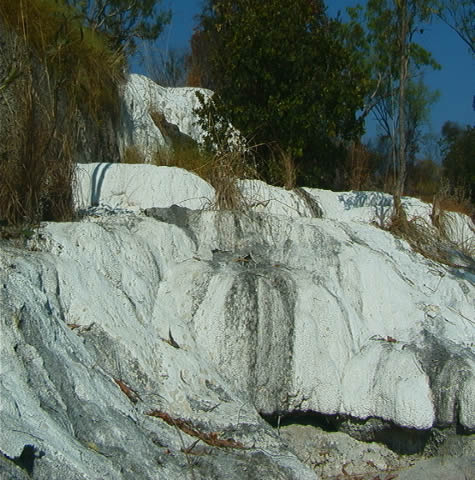Limestone Gorge - Rillenkarren
THEME: Limestone Gorge
SUBJECT AREA: Science
TOPIC: Rillenkarren
Following the advice on the National Parks Commission sign, we visited the Calcite flow at sunrise, to watch the morning light sparkle on the cascades. This white formation appears in the steep dry creek bed as a rushing waterfall, frozen in time. The turbulence of the fast flow of calcium-rich waters down this slope forced carbon dioxide (the same gas which animals convert the air they breathe into) out of the water. This chemical reaction results in the release of solid calcium carbonate (called calcite) from the water.
Over time, layer upon layer of calcite sediment builds up around solid objects – in this case, tree roots and rock. Eventually we are left with the striking white cascades we saw at Limestone Gorge, which could easily fool an uninitiated onlooker to think that water was flowing there.

Each wet season, the calcite cascades trap minute algae and other small organisms, causing them to change colour until they die in the dry season, leaving the white calcite exposed.
“This site holds particular significance for the local Ngariman Aboriginal people. It forms a part of their Flying Fox dreaming, which extends across many of the watercourses and natural features of this area. Traditionally the white calcite (Kulge) was used to make body paint for ceremonial purposes which were held in the vicinity of the present Limestone Gorge camping area.”
Near the Calcite flow, we saw a rock formation that had baffled us 65 days ago, in the Chillagoe caves, where another limestone founded land system exists. The exposed limestone surface resembles tiny choppy waves on a lake, with hundreds of sharp peaks, and, we finally discovered, is known as Rillenkarren. In Chillagoe, there had been no interpretive signs to tell us about it, and while the intrigue had been captivating, it was great to see it again, and to understand just how it was formed.
Rillenkarren is created by acidic rain - a very different type to that which cities may get from pollution. It is actually just a weak carbonic solution that is formed in the clouds. The carbonic solution dissolves the softer limestone rock causing a jagged, rippled effect. Dolomite, the type of limestone found throughout the park, is subject to rapid corrosion from many sources.
See Crister’s Geography update for info on some other neat geological phenomenon found in the Karst landscape.
The aboriginal people found a process that made splitting the rillenkarren easy. A chunk of rock is heated in a fire then cooled very quickly by dipping the stone into a creek. This gives the remaining rock splinters rather sharp edges, useful for crafting spearheads, knife-edges and axe heads.
Suggested learning activities:
Research the element Calcium. How much is there in the earth’s crust? Where is it found? What are its commercial uses? What purpose does it serve in our bodies? Find out all the practical information you can on this mineral.
Explore the commercial uses of Limestone. Many uses have been found for the stone in places where it is abundant around the world, just as the aborigines did. In the United States, it has been used for building fence posts, houses, flooring etcetera. What uses can you think of? What other types of limestone are there apart from Dolomite?
Feed your children wheat Joshua and bel

